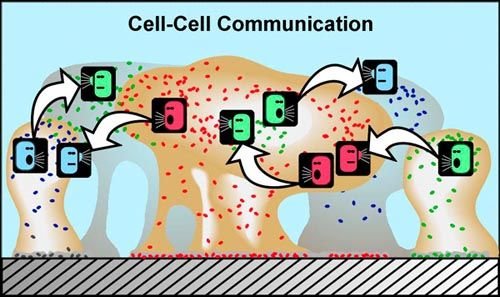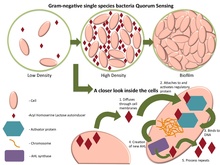??How do Bacteria Talk?? Click to Find Out
Sociobiology is the scientific study of the biological (especially ecological and evolutionary) aspects of social behaviour in animals and humans. The past 20 years has given rise to an explosion of research in sociobiology applied to microbiology. Here we explore recent developments in the understanding of how microbes have become such convivial communicators.

Bacterial are the some of the oldest living organisms. THey have been here for billions of years. These single cell microorganisms only have one piece of DNA. Therefore they have very few genes to do what they need to do. This is what makes it amazing for them to be so successful.
Bacterials main goal is to consume nutrients grow to twice their size and then dived; and on and on and on. This seemingly boring existence comes with an amazing human interaction. When it comes to the human body there is about a 1: 10 ratio human cells are completely outnumbered by bacterial cell. These bacteria are essential to our survival!
Bacteria are everywhere in massive numbers, helping us live and sometimes threatening are very existence. Nevertheless, these bacteria are virtually nonexistent to us in low amount of numbers. It is only when bacteria start to communicate with each other in numbers do they start to affect the lives of macroorganisms. So how do Bacteria communicate?

Originally this question was identified in the 1960’s and 70’s when scientists discovered instances of bacteria producing extracellular molecules as a form of cell-to-cell signaling. It took nearly 20 additional years for scientists to generate undeniable evidence of this with the use of genetics. By discovering the genes that were used to respond to such signals, scientist could prove their communication by controlling their ability to perceive certain molecules. The first case of this was demonstrated by the gene that is related to bioluminescence. If you are not familiar with this process. Check out this quick video of some bacteria who possess this ability.
The process of Bioillumination is not a simply gene to protein relationship. The process goes through a multi-step synthesis that produces many other compounds that are useful to the bacterial other than the bioilluminescence signal. At this time in the 80’s these discoveries were not very useful, but were amazingly interesting(and expensive). Into the 90’s, as DNA sequencing became essential to most laboratories, different applications of this knowledge could be put to use. Finding analogs of the different genes involved in this process allowed scientist to more easily understand how other species of bacterial were producing costly proteins only at the right times.
The multi-step process shows that it takes a lot of nutrients and resources for a single bacteria to perform an action such as bacterial conjugation(transfer of genetics), coenzyme production, or produce helpful antibiotics. Such a costly process is not beneficial when in small numbers, it would take a certain number of bacteria to reach the threshold necessary to perform the action for the benefit of the entire colony and itself. In each case the bacterial are detecting a chemical trace to tell them when it is beneficial to perform their action. This type of communication allows them to understand when they have a sizable biomass to benefit from performing a costly action. This process was dubbed Quorum Sensing in the 1990’s.

As with all socialistic goods there are bound to be slackers. Many examples of bacterial exploiting there brothers at the game of QS have been recorded in bacterial cultures. Pseudomonas aeruginosa requires QS to induce extracellular protease production which allows for growth on protein plates. At a relatively low frequency, QS cheaters do not produce these costly proteases but still consume the reward giving themselves a fitness advantage. Furthermore, mixed strains of cheaters and producers are less successful than homogenous strains of producers. This has pushed researchers into exploring the possibilities of weakening certain virulence bacteria by introducing cheaters into their population.
Recently research has turned to bacteria located in the human gut. The bacteria that inhabits our guts are known as the microbiome. The microbiome is known for controlling many factors of human life; digestion, immunity, nutritional uptake, and even mood. These bacterial interact in more complex ways than the simplicity explained in this article. As research continues in this field scientist are continuing to unravel the complexities of bacterial communication. Stay on the lookout for progression in this field as it has several potential benefits to our lives
Please upvote and follow to help me continue to post interesting content! I truly appreciate everyone's help, and for all of the support you give, you can count on me to give it back!!!=D
Souces:
Wikipedia & Nature.com
That is a very interesting post. I think it would be very useful, for the readers, to add extra references where more information could be found (under the form of clickable links). In addition, I am fully convinced this will bring you more rewards ;)
Thanks in advance for your consideration.
Thank you so much for that advice ! I just learned how to do that yesterday! I think you are right! Please follow me so you can see your advice get put into action!